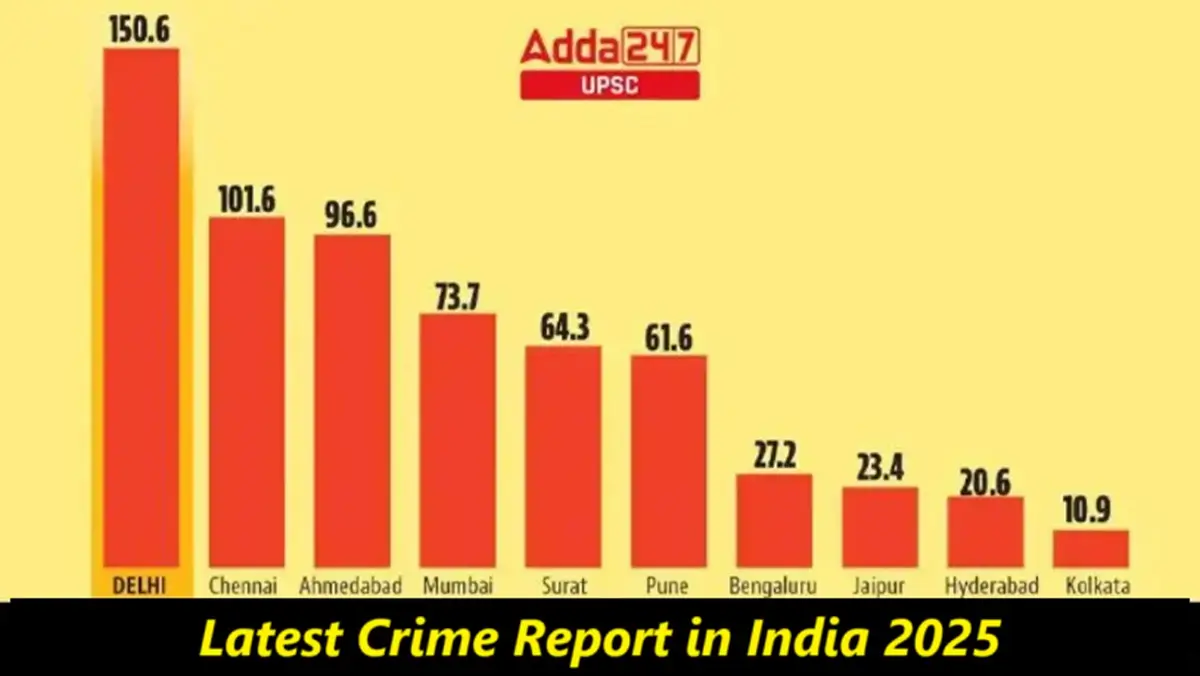Table of Contents
The National Crime Records Bureau (NCRB), under the Government of India, records all types of crimes. Each year, the State Crime Records Bureau (SCRB) collects data from the District Crime Records Bureau (DCRB) and submits it to the NCRB for its annual report. Data from megacities (cities with a population of one million or more) is also included. The first edition of ‘Crime in India’ pertains to the year 1953 and the latest edition of the report pertains to the year 2022.
This data, categorized by various Indian Penal Code (IPC) sections, is released separately by district. According to the NCRB, India’s crime rate decreased from 487.8 incidents per 100,000 people in 2020 to 445.9 in 2021. Crime rates and occurrences vary by state and type of crime. Understanding this data is crucial for UPSC preparation as it provides insights into India’s crime trends and patterns.
Latest Crime Rate Report of India 2025
India’s 2025 crime report shows a small decrease in overall crime, down by 0.6% from 2024. However, rape cases rose by 1.1%, and kidnappings increased by 5.1%. Crime is still higher in cities than rural areas. The decline in overall crime is due to a stronger police presence, better law enforcement, and increased public awareness. The report also calls for better police training, more resources, and closer cooperation between police and communities for continued progress.
Overall Crime Rate: In 2025, there were 445.9 reported crimes for every 100,000 people in India.
- Common Crimes: The most frequent crime is theft, followed by robbery and assault.
- High Crime States: Uttar Pradesh, Kerala, Maharashtra, Delhi, and Bihar have the highest crime rates.
- Urban vs. Rural: Crime rates are higher in urban areas compared to rural ones.
- Reasons for Decrease: The overall crime rate has decreased due to more police presence, better law enforcement, and increased public awareness about crime.
- Challenges Ahead: Despite the improvements, there are still challenges, including the need for better training for police officers and more resources for law enforcement.
States with the most Number of Crimes Rate
According to the National Crime Records Bureau (NCRB), India’s crime rate in 2025 was 445.9 per 100,000 people. The theft was the most common crime, followed by robbery and assault. The states with the highest crime rates included Uttar Pradesh, Kerala, Maharashtra, Delhi, and Bihar.
The report also noted an alarming increase in cybercrimes and domestic violence, highlighting a shift in criminal activity. Urban areas experienced a notable rise in reported offenses, raising concerns about the effectiveness of current law enforcement strategies in managing crime in rapidly growing cities.
- Uttar Pradesh: The per capita crime rate of UP is 7.4. According to the National Crime Records Bureau, this ratio means that Uttar Pradesh has the highest number of crimes, and thus, the state is unsafe to travel alone.
- Arunachal Pradesh: The crime rate and other factors have made the state responsible for coming second in danger. Travelling alone after dark is banned in many areas of Arunachal Pradesh. The crime rate is around 5.8 and it is increasing with the increasing number of crimes.
- Jharkhand: Jharkhand is another state which should not be missed from the point of view of danger. Little has been done for the safety of the people. Many criminal cases are not even registered in the police files. Talking about the ratio, the per capita crime rate in the state has been recorded at 5.3.
- Meghalaya: Meghalaya ranks fourth in terms of security and crime. Some areas in Meghalaya are said to be unsafe for travel and restricted for people. In recent reports, the state was declared with crimes per capita of 5.1 and is considered one of the top dangerous states in India.
- Delhi: Although Delhi ranks fifth, the state has a crime rate of 5 per capita as per the crime bureau. The sad fact is that despite the reign of political power in the state; Very little has been done in terms of its safety.
- Assam: Ranks sixth in terms of crime rate in India. As compared to other states, Assam has registered a crime ratio of 4.4 per capita in India. We are yet to go with 4 more top dangerous states in India.
- Chhattisgarh: Crime has also increased to a great extent in Chhattisgarh. The state has a crime rate rating of 4 per capita and this is an alarming number enough to mention. This place is considered unsafe for many reasons, especially for women.
- Haryana: Haryana has recorded a per capita crime rate of 3.8. The state is known for robbery, theft, bribery, murder, rape, and more. Thus, the political powers are trying to take stringent measures to control the crime rate. It is also called one of the 10 most dangerous states of India.
- Odisha: Also shares 3.8 per capita crimes in India. The place is known for larceny, theft, and bribery. Various areas have been targeted for drugs and drunkenness. It has also spoiled the youth to a great extent in drug addiction.
- Andhra Pradesh: Last but, not least is the crime rate in Andhra Pradesh. The state has increased to a 3.6 per capita crime ratio in India.
Crime In India
The crime data in India is provided below in the form of a table.
| Year | Crime Rate |
| 1953 | 160 |
| 1963 | 143.5 |
| 1973 | 187.9 |
| 1983 | 187.4 |
| 1993 | 184.4 |
| 2003 | 514.4 |
| 2013 | 540.4 |
| 2023 | 422.2 |
Major Crime Categories and Trends
Analyzing major crime categories and trends helps us understand the current crime situation in India. These categories cover various offenses, including homicide, assault, theft, robbery, and sexual offenses. Looking at trends within these areas gives insight into changing patterns and tactics used by criminals. For example, cybercrime—such as online fraud and identity theft—has become a major concern.
Crimes against women and children, like sexual assault and child abuse, are also a serious worry. Keeping a close watch on these crime categories and spotting new trends is crucial for law enforcement and policymakers. This helps in creating effective crime prevention strategies to protect the public and ensure safety.
Impacts of Crime on Society and Economy
Social Impact Crime Rate Report:
- Generates feelings of fear, mistrust, and insecurity.
- Reduces overall quality of life.
- Causes a breakdown in social bonds and increases isolation.
- Leads to decreased community involvement.
- Inflicts enduring physical and psychological trauma on victims and their families.
Economic Impact Crime Rate Report:
- Imposes a substantial burden on healthcare expenses.
- Leads to diminished productivity.
- Increases costs associated with law enforcement and the criminal justice system.
- Deters investments, hindering economic growth.
- Negatively affects a country’s reputation, impacting tourism and foreign direct investment.
Addressing crime is essential for cultivating a safer society and promoting economic prosperity.
NCRB Report on Crime in India
The 2022 report from the National Crime Records Bureau (NCRB) offers a detailed analysis of the crime landscape in India. This publication is crucial for policymakers, law enforcement agencies, and researchers as it helps them understand and address the complexities and variations in criminal behavior across the country. However, interpreting the insights from this report requires an understanding of its nuances, methodologies, and limitations. This article delves into the key findings of the 2022 Crime Rate Report, the data compilation processes, the disparities observed among states, and the significant challenges related to the data presented.
Key Findings of the NCRB Report 2025
The NCRB’s 2022 report offers an extensive glimpse into the crime data across India. With a total of 5,824,946 cognizable crimes reported, a notable decrease of 4.5% compared to the preceding year. These figures include 3,561,379 Indian Penal Code (IPC) crimes and 2,263,567 Special and Local Laws (SLL) crimes, reflecting a diverse range of legal infractions. Below, you’ll find comprehensive details of the crime statistics.
| Category | Statistics |
|---|---|
| Overall Crime Statistics (2022) | |
| Total Cognizable Crimes | 58,24,946 |
| Year-on-Year Change | -4.5% |
| IPC Crimes | 35,61,379 |
| SLL Crimes | 22,63,567 |
| Crime Rate (per lakh population) | 422.2 (2022) vs. 445.9 (2021) |
| Crimes Against Women (2022) | |
| Total Cases Registered | 4,45,256 |
| Year-on-Year Change | +4% |
| Top Categories of Cases | – Cruelty by Husband or His Relatives |
| – Kidnapping & Abduction of Women | |
| – Assault on Woman with Intent to Outrage Her Modesty | |
| Cyber Crimes and Suicides (2022) | |
| Cyber Crimes | +24.4% (majority cases: Fraud) |
| Suicides | +4.2% (reasons: Family problems, Marriage-related issues, Illness) |
| ALSO READ | |
| National Crime Records Bureau (NCRB) | Accidental Deaths and Suicides in India report: NCRB |
| National Suicide Prevention Strategy | Rules Governing Criminal Procedure |



 TSPSC Group 1 Question Paper 2024, Downl...
TSPSC Group 1 Question Paper 2024, Downl...
 TSPSC Group 1 Answer key 2024 Out, Downl...
TSPSC Group 1 Answer key 2024 Out, Downl...
 UPSC Prelims 2024 Question Paper, Downlo...
UPSC Prelims 2024 Question Paper, Downlo...





